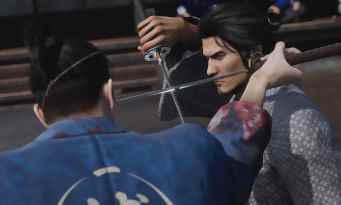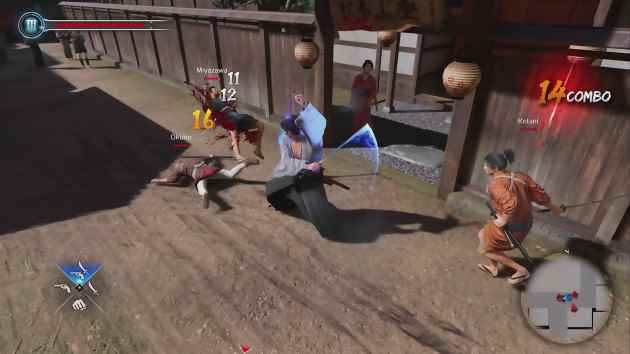Released in Japan in 2014, for the launch of the PS4, Yakuza Ishin (real name Ryu Ga Gotoku Ishin) is not the first episode to venture into the Japan of yesteryear. In 2008, the studio had already tried the experiment with Yakuza Kenzan, the first spin-off to go from the contemporary era to the Edo period, in 1605. If the latter is still a Japanese exclusive, the Yakuza Ishin will be able to reveal all its secrets to us in a few weeks, the game arriving on PC and all the consoles of the moment, except the Nintendo Switch. If we will have to wait for greater popularity of the franchise to hope to see a complete VF land, we can at least be satisfied with subtitles in French, undoubtedly the best way to fully immerse yourself in the Japanese atmosphere of this title, which is a journey in all circumstances. It must be said that by propelling us into full Bakumatsu (from 1853 to 1868), the period which marks the end of the shogunate and the Edo era, Japan put an end to its isolationist policy and authorized foreigners to bring their knowledge -do in the country. We are not going to give you a history lesson on this period of opening of Japan to the Western world, Wikipedia being better placed than us, but it allows to better situate the stakes and the gameplay of this Yakuza Ishin. Moreover, the name Yakuza Ishin is no longer valid, since the game has been renamed Like a Dragon Ishin, which also marks the end of an era, when Toshihiro Nagoshi reigned supreme within SEGA, he who also held the position of producer – and sometimes creative director – on the Yakuza franchise. Its – forced – departure for the Chinese from NetEase is therefore a way for SEGA to cut the cord by changing the name, which only concerns the West. Yes, we know, it’s complicated. Like any breakup.
ICHIBAN JAPAN
By placing its story in the middle of Bakumatsu, Like a Dragon Ishin decided to rely on many historical facts, in order to bring a good dose of credibility to its story. The latter will remain identical to the one that was shaped almost ten years ago on PS3 / PS4, and those who know the source material will therefore not be out of place. For the others, they will discover a world in full political and even cultural change, in which a hint of alternate history will be added. Indeed, the game will allow us to follow the adventures of a certain Sakamoto Ryôma, a historical character who existed (and who participated in overthrowing the Tokugawa shogunate), but the latter is represented in the game as being a descendant of Kazuma Kiryu, the heroes of the main series. The demo that we discovered during our preview in Berlin was not intended to spread over the story, but rather to introduce us to the gameplay, the open play areas, the activities and above all some scripted missions. The basic structure of Like a Dragon Ishin remains the same as any other Yakuza, it’s the historical context that changes the game a bit.
By placing its story in the middle of Bakumatsu, Like a Dragon Ishin decided to rely on many historical facts, in order to bring a good dose of credibility to its story. The latter will remain identical to the one that was shaped almost ten years ago on PS3 / PS4, and those who know the source material will therefore not be out of place. For the others, they will discover a world in full political and even cultural change, in which a hint of alternate history will be added.
The first element with which we immediately became familiar was the combat system, divided into four different styles: Swordsman, Gunman, Brawler and Wild Dancer. If SEGA has communicated a lot about it in recent months, being able to test them with the controller in hand allowed us to know which of the 4 styles suited us the most. Each technique has its own advantages and disadvantages, but also its specific finish moves, and the player is free to switch from one to the other as he sees fit. Obviously, given the context of the time, the “saber” (Swordsman) and the “kanata-sword” (Wild Dancer) styles are likely to obtain a certain preference among players. Not that bare-handed combat and the gun are not interesting to play, but they are clearly not the preferred styles, especially against the “bosses” who will have more than one deceit behind their heads to make us bite our teeth. dust. That said, regardless of the combat technique chosen, Sakamoto Ryôma is able to dodge enemy attacks by sliding sideways or rolling, which is very practical for not finding yourself cornered in front of an opposing combo. Of course, everything is done to achieve magnificent sequences and it will only take a few minutes to become familiar with the controls, since there is no complicated or hazardous manipulation.
NEW AND AT LEAST NEW
Inevitably, having been released first in 2014, the controls of Like a Dragon Ishin may seem a bit rigid for this version which comes out in 2023. One would have thought that the developers had relaxed the gameplay, but in reality, it is the same feeling as ten years ago, with animations that lack flexibility, both in movement and attack movements. Attention, nothing very dramatic, Like a Dragon Ishin can be appreciated as a whole, also because the fans are already used to this old school mood which is also somewhere a trademark of the series. Far be it from us to be more conciliatory with this game than another remake, because it is true that the game still shows its mechanics a little too old. In fact, it is mainly in its cinematics that we see the visual changes made between the 2014 game and the one that returns in 2023. Of course, the display has been refined, but roughly speaking, we are closer to a remaster than a remake.
Fortunately, Like a Dragon Ishin has for him a very appreciable atmosphere, especially if you are a lover of Japan, the open areas managing to transcribe the very special atmosphere of a Japan that some would have loved to know or at least to browse. The city of Kyoto is a real pleasure to browse, with a myriad of shops to visit, whether it’s a simple restaurant, or a room where you can dance with your fans in your hand. There is even the ancestor of the famous Don Quijote, a store in which you can find everything and anything, with a tenant capable of finding the least of his objects in his shop. As usual, Like a Dragon Ishin gives pride of place to activities and other mini-games, but also does not forget to give life to the different NPCs that you can meet in the city. It will not be uncommon to come across a child with whom one can forge a friendship, or even help a lost old lady to accompany her home. And then there’s this distraught woman because her only son doesn’t do anything with his life except vegetate in his room 24 hours a day for some reason beyond her. By taking the time to talk with each of these randomly encountered NPCs, we unlock specific, scripted missions, which we allow you to bring even more life and humanity to this city, but also to learn more on the character of Sakamoto Ryôma and his values. SEGA’s game takes time to set the scene and develop the characters, so both main missions and side quests prove to be just as exciting. So of course, Like a Dragon Ishin is far from perfect, and it still shows an old school realization, like this absence of dialogues outside of the worked cutscenes. Often, you will therefore come across silent exchanges, embellished with a few sound effects here and there, but nothing more. A classic of the franchise that we hope to see evolve to take an additional step in future episodes.



